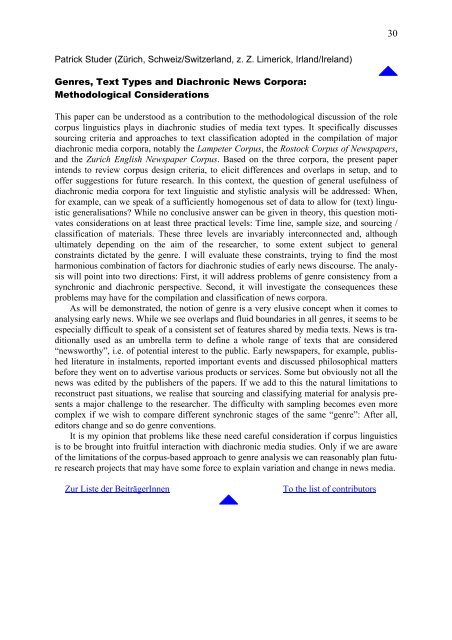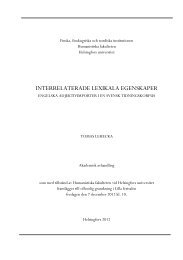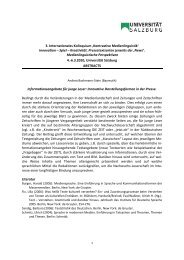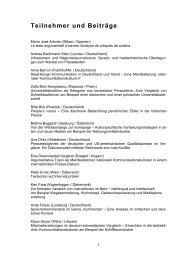Abstracts - Kontrastive Medienlinguistik
Abstracts - Kontrastive Medienlinguistik
Abstracts - Kontrastive Medienlinguistik
Sie wollen auch ein ePaper? Erhöhen Sie die Reichweite Ihrer Titel.
YUMPU macht aus Druck-PDFs automatisch weboptimierte ePaper, die Google liebt.
Patrick Studer (Zürich, Schweiz/Switzerland, z. Z. Limerick, Irland/Ireland)<br />
Genres, Text Types and Diachronic News Corpora:<br />
Methodological Considerations<br />
This paper can be understood as a contribution to the methodological discussion of the role<br />
corpus linguistics plays in diachronic studies of media text types. It specifically discusses<br />
sourcing criteria and approaches to text classification adopted in the compilation of major<br />
diachronic media corpora, notably the Lampeter Corpus, the Rostock Corpus of Newspapers,<br />
and the Zurich English Newspaper Corpus. Based on the three corpora, the present paper<br />
intends to review corpus design criteria, to elicit differences and overlaps in setup, and to<br />
offer suggestions for future research. In this context, the question of general usefulness of<br />
diachronic media corpora for text linguistic and stylistic analysis will be addressed: When,<br />
for example, can we speak of a sufficiently homogenous set of data to allow for (text) linguistic<br />
generalisations? While no conclusive answer can be given in theory, this question motivates<br />
considerations on at least three practical levels: Time line, sample size, and sourcing /<br />
classification of materials. These three levels are invariably interconnected and, although<br />
ultimately depending on the aim of the researcher, to some extent subject to general<br />
constraints dictated by the genre. I will evaluate these constraints, trying to find the most<br />
harmonious combination of factors for diachronic studies of early news discourse. The analysis<br />
will point into two directions: First, it will address problems of genre consistency from a<br />
synchronic and diachronic perspective. Second, it will investigate the consequences these<br />
problems may have for the compilation and classification of news corpora.<br />
As will be demonstrated, the notion of genre is a very elusive concept when it comes to<br />
analysing early news. While we see overlaps and fluid boundaries in all genres, it seems to be<br />
especially difficult to speak of a consistent set of features shared by media texts. News is traditionally<br />
used as an umbrella term to define a whole range of texts that are considered<br />
“newsworthy”, i.e. of potential interest to the public. Early newspapers, for example, published<br />
literature in instalments, reported important events and discussed philosophical matters<br />
before they went on to advertise various products or services. Some but obviously not all the<br />
news was edited by the publishers of the papers. If we add to this the natural limitations to<br />
reconstruct past situations, we realise that sourcing and classifying material for analysis presents<br />
a major challenge to the researcher. The difficulty with sampling becomes even more<br />
complex if we wish to compare different synchronic stages of the same “genre”: After all,<br />
editors change and so do genre conventions.<br />
It is my opinion that problems like these need careful consideration if corpus linguistics<br />
is to be brought into fruitful interaction with diachronic media studies. Only if we are aware<br />
of the limitations of the corpus-based approach to genre analysis we can reasonably plan future<br />
research projects that may have some force to explain variation and change in news media.<br />
Zur Liste der BeiträgerInnen To the list of contributors<br />
30





